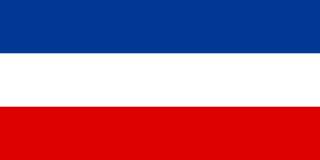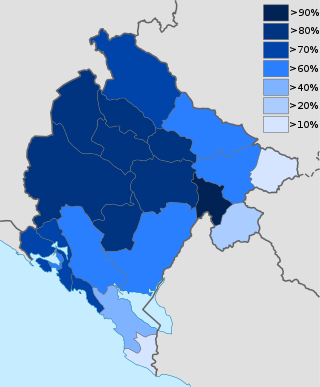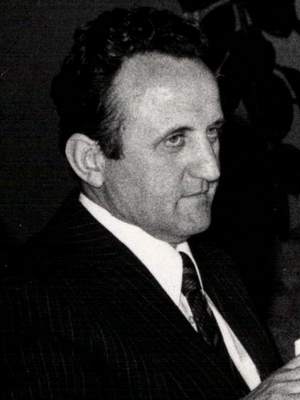History
Origin
The concept of citizenship in Montenegrin law can be traced back to the laws promulgated in 1803 by Petar I Petrović-Njegoš, which articulated the principle of jus sanguinis in reference to Crnogorac (Montenegrins) and Brdjanin (Highlanders), and then to the legal code of 1855, which reiterated the earlier principles and also granted foreigners the right to reside in Montenegro. [1] In 1905, Nicholas I of Montenegro's "Statute of Montenegro" promulgated further guidelines, for the first time using the term "Montenegrin citizens" instead of "Montenegrins" and "Highlanders", and also establishing the right of renunciation of citizenship after completion of military service. However the law did not spell out the guidelines for acquisition of citizenship. [2]
Kingdom of Yugoslavia and Socialist Federal Republic of Yugoslavia
When Montenegro was a part of Yugoslavia, it had citizenship policies in common with the rest of the country. The Kingdom of Yugoslavia passed a formal citizenship act in 1928, establishing that citizenship would be acquired by patrilineal descent. The Socialist Federal Republic of Yugoslavia (SFRY) for its part passed a citizenship act in 1945, which stated that Yugoslav citizenship was held by people who were citizens under the 1928 act and people who had the ethnicity of one of the Yugoslav republics; it also deprived emigrants of their citizenship, and prohibited multiple citizenship. [3] The constituent republics, including the Socialist Republic of Montenegro, passed their own citizenship acts, which mirrored the federal acts and provided for acquisition of citizenship of the constituent republic along with federal citizenship. Citizenship of a constituent republic came from descent rather than place of birth; in the case of two parents with citizenship of different republics, the citizenship of the child depended on agreement by the parents, or lacking such agreement, a legal determination based on the child's place of residence. [4]
Until the breakup of Yugoslavia there were two further changes to nationality laws, each being passed soon after the adoption of a new Constitution of Yugoslavia. The Citizenship Act of 1964 removed the provisions for depriving emigrants of citizenship, as well as establishing procedures for naturalisation. It also clarified the relationship that if one lost federal citizenship, then republic citizenship would be lost as well. [5] The 1976 Citizenship Act clarified the mechanism for acquisition of citizenship of a republic by citizens of other republics. By the time the federal legislation was passed, the constituent republics had already adopted new citizenship legislation in line with the new constitution. Montenegro was the first to pass such legislation, in May 1975; it would remain in force until 1999. [6]
Federal Republic of Yugoslavia and State Union of Serbia and Montenegro
The constitution of the Federal Republic of Yugoslavia (FRY, comprising Serbia and Montenegro) passed in 1992 continued the two-tier structure of federal citizenship and republic citizenship. [7] However, the actual citizenship act governing the details of acquisition of citizenship in the FRY was not passed until 1996. [8] It automatically gave citizenship in the FRY to everyone who had republic citizenship of Serbia or of Montenegro under the SFRY. It also provided that people who held SFRY citizenship, were permanently resident on the territory of the FRY at the time of the promulgation of the constitution, and had no other citizenships could apply for FRY citizenship. However it required that they renounce their former citizenship in the process. [9] It also stated that a person acquiring FRY citizenship by naturalisation would also acquire the citizenship of the republic on whose territory the event of naturalisation occurred. [10]
In 1999, as the NATO bombing intensified, Montenegro passed its own nationality law which changed the relationship between federal and republic citizenship, seen as a move to establish greater independence from the federal government. The law provided mechanisms for obtaining Montenegrin citizenship even in the absence of FRY citizenship; it also stated in Article 16 that a Montenegrin citizen who acquired citizenship of another republic or a foreign country would lose his citizenship. [11] It also established particularly stringent criteria for naturalisation, in an effort to prevent refugees from Bosnia and Herzegovina and from Croatia from gaining voting rights in Montenegro. [12] However, there were significant changes to the federal citizenship laws in the aftermath of the overthrow of Slobodan Milošević; specifically, Articles 47 and 48 were modified to permit people who held SFRY citizenship to obtain FRY citizenship without giving up any other citizenship they held, thus effectively permitting multiple citizenship for the first time in the history of the nationality law. [13] Under reformulation of the FRY as the State Union of Serbia and Montenegro in 2003, the Constitutional Charter of Serbia and Montenegro further clarified the relationship between citizenship and voting rights: it stated in Article 7 that citizens of Serbia and of Montenegro residing in the other would each have full rights, but with the specific exception of voting rights. Furthermore, under republic-level law, Montenegrins living in Serbia had no voting rights in Montenegro either. This distribution of voting rights effectively laid the ground for the passage of the Montenegrin independence referendum, 2006. [14] [15]
Post-independence
After Montenegro became an independent country in 2006, article 12 of the new Constitution of Montenegro passed in 2007 established Montenegrin citizenship. The Law on Implementation allowed people who had dual citizenship before independence to retain that dual citizenship. However, it did not permit people who obtained another citizenship afterwards to retain dual citizenship, instead requiring to give up one or the other citizenship within a year. However this clause was the subject of political tensions, and led to delays in the passage of a formal citizenship act. [16] The Citizenship Act of 2008 clarified the exact mechanisms for gain and loss of citizenship. It also defined the character of citizenship in Montenegro as "civic" rather than "ethnic". [17] It continued to impose strict requirements for naturalisation. [18]
Under the new nationality law, Articles 8 and 9 provide that persons applying for naturalisation in Montenegro must provide proof of having given up their previous citizenship, while Article 24 provides that Montenegrins acquiring citizenship of another country lose their Montenegrin citizenship. However, Article 18 provides exceptions from this general prohibition against multiple nationality in the case of a bilateral treaty between Montenegro and the other country of citizenship. [19] In 2012 it was reported that Montenegro and Serbia were negotiating such a treaty. [20]
Economic citizenship
In addition to the rather strict mechanisms for naturalisation, Montenegro has a programme of citizenship-by-investment or economic citizenship (ekonomsko državljanstvo), allowing foreigners to be granted the citizenship of Montenegro at the discretion of the Ministry of Interior Affairs and Public Administration. [22] Though the enabling legislation remains in place, the programme was suspended in November 2010. [23]
Article 12 of the Citizenship Act of 2008 states that "An adult person may be granted Montenegrin citizenship if he or she does not fulfil the requirements referred to in Article 8 of this Law if it would be in the scientific, economic, cultural, sport, national, or other interest of Montenegro". [24] In March 2010, former Prime Minister of Thailand Thaksin Shinawatra received citizenship under this article due to his investments in tourism in Montenegro which were reported to be in the range of millions of Euros, despite pending charges of corruption that had been laid against him in his home country. [25] The move sparked public criticism, but government spokeswoman Olivera Đukanović dismissed the concerns by claiming that other countries had similar programs. [26]
Formal guidelines for the programme were announced in mid-2010; they stated that candidates would require €500,000, of which one portion would be invested inside the country and the rest would have to be contributed to the state budget. [22] [26] In the light of German reports in August that Oleg Deripaska would be granted citizenship under the programme, more criticism emerged. Movement for Changes leader Nebojša Medojević as well as Vanja Ćalović of NGO MANS were quoted as warning that the programme would attract gangsters and increase corruption. Budimir Aleksić of the Poslanik Nove for his part complained that the government would "sell citizenship" while leaving 60,000 residents of Montenegro stateless. [25] Stephan Meyer of Germany's Christian Social Union also spoke out against it, and said it might threaten the recent moves to grant Montenegrin passport-holders visa-free travel within the Schengen Area. [27] [26] However others offered public praise to the programme, including Canadian ambassador to Serbia, Montenegro, and Macedonia John Morrison, who compared it to Canada's own visa policy, which has provisions for granting visas to investors. [28]
Later in August, when rumours surfaced that Serbian businessman Miroslav Mišković was in the process of applying for citizenship under the program, then Prime Minister Milo Đukanović denied the reports, and further stated that the process of receiving applications for economic citizenship under the new guidelines had not yet begun. [29] Then in November 2010, the Montenegrin Ministry of Foreign Affairs formally announced the suspension of the previous guidelines about economic citizenship. Media reports attributed this action to pressure from the European Union, though MFA spokesman Zeljko Stamatović denied it. [23] [30] As of June 2011, the programme remained suspended. [31] According to a Dnevne Novine report; concerns remained that the citizenship-by-investment programme would not attract genuine investors but only people engaged in money laundering and those who sought to hide from crimes committed abroad (as Montenegro does not extradite its citizens). [32] However, others argue that the programme could help in attracting foreign investment capital to Montenegro, especially from Americans living abroad who remain fully subject to U.S. taxation unless they switch citizenships. [31]
In 2019, Montenegro began taking applications for a new program of citizenship by investment. This new program is limited to two thousand successful applicants and will only run for three years maximum. [33] [34] The program is limited to non-EU citizens. [35]

Montenegro is a country in Southeastern Europe, on the Balkan Peninsula. Its 25 municipalities have a total population of 633,158 people in an area of 13,812 km². It is bordered by Bosnia and Herzegovina to the northwest, Serbia to the northeast, Kosovo to the east, Albania to the southeast, Croatia to the west, and has a coastline along the Adriatic Sea to the southwest. The capital and largest city is Podgorica, while Cetinje is the Old Royal Capital and cultural centre.

The State Union of Serbia and Montenegro or simply Serbia and Montenegro, known until 2003 as the Federal Republic of Yugoslavia, FR Yugoslavia (FRY) or simply Yugoslavia, was a country in Southeast Europe located in the Balkans that existed from 1992 to 2006, following the breakup of the Socialist Federal Republic of Yugoslavia. The state was founded on 27 April 1992 as a federation comprising the Republic of Serbia and the Republic of Montenegro. In February 2003, it was transformed from a federal republic to a political union until Montenegro seceded from the union in June 2006, leading to the full independence of both Serbia and Montenegro.
As the economy of the Socialist Federal Republic of Yugoslavia collapsed and entered a prolonged decline in 1989, the country broke up into five new sovereign states by 1992, independence of which was fought over in a series of Yugoslav Wars. The rump state that continued to designate itself as 'Yugoslavia' was established as a confederation of two of these successor states, Serbia and Montenegro.

Alexander, Crown Prince of Yugoslavia, is the head of the House of Karađorđević, the former royal house of the defunct Kingdom of Yugoslavia and its predecessor the Kingdom of Serbia. Alexander is the only child of King Peter II and his wife, Princess Alexandra of Greece and Denmark. He held the position of crown prince in the Democratic Federal Yugoslavia for the first four-and-a-half months of his life, until the declaration of the Federal People's Republic of Yugoslavia later in November 1945, when the monarchy was abolished. In public he claims the crowned royal title of "Alexander II Karadjordjevic" as a pretender to the throne.
Unique Master Citizen Number is an identification number that was assigned to every citizen of former Yugoslav republics of the SFR Yugoslavia. It continues to be used in almost all of the countries that were created after the dissolution of Yugoslavia – Bosnia and Herzegovina, Montenegro, North Macedonia, Serbia and Slovenia use it in its original form, while Croatia has switched to a new identification number called the Personal Identification Number.

After a period of political and economic crisis in the 1980s, the constituent republics of the Socialist Federal Republic of Yugoslavia split apart, but the unresolved issues caused a series of inter-ethnic Yugoslav Wars. The wars primarily affected Bosnia and Herzegovina, neighbouring parts of Croatia and, some years later, Kosovo.

Citizenship of Serbia is regulated by the 2004 Citizenship Act, based primarily on the principle of Jus sanguinis. Article 23 of the citizenship law stipulates that any foreign national with Serbian descent has the right to acquire Serbian citizenship by written request. In certain cases, the act also allows dual citizenship, allowing an individual the right to retain his or her current citizenship and receive Serbian citizenship.

The 1992 Montenegrin independence referendum was the first referendum regarding Montenegrin independence, held on 1 March 1992 in SR Montenegro, a constituent republic of the Socialist Federal Republic of Yugoslavia.

The current Constitution of Montenegro was ratified and adopted by the Constitutional Parliament of Montenegro on 19 October 2007 in an extraordinary session by achieving the required two-thirds supermajority of votes. It was officially proclaimed on 22 October 2007, replacing the constitution of 1992.

Marko Orlandić was a high-ranking Montenegrin politician in the Socialist Federal Republic of Yugoslavia (SFRY) during the 1970s and '80s. He was born in Seoca, Yugoslavia.
The Arbitration Commission of the Conference on Yugoslavia was an arbitration body set up by the Council of Ministers of the European Economic Community (EEC) on 27 August 1991 to provide the conference on Yugoslavia with legal advice. Robert Badinter was appointed to President of the five-member Commission consisting of presidents of Constitutional Courts in the EEC. The Arbitration Commission has handed down fifteen opinions on "major legal questions" raised by the conflict between several republics of the Socialist Federal Republic of Yugoslavia (SFRY).

The Montenegrin passport is the primary document for international travel issued by Montenegro.

Teams from Yugoslavia first participated at the Olympic Games in 1920. Previously, several athletes from Croatia, Slovenia and northern Serbian province Vojvodina had competed for Austria or Hungary when those countries were part of the Empire of Austria-Hungary. A small team of two athletes had competed distinctly for Serbia at the 1912 Summer Olympics.

The Republic of Serbia was a constituent state of the Federal Republic of Yugoslavia between 1992 and 2003 and the State Union of Serbia and Montenegro from 2003 to 2006. With Montenegro's secession from the union with Serbia in June 2006, both became sovereign states in their own right for the first time in nearly 88 years.

The Republic of Montenegro was a constituent federated state of the Federal Republic of Yugoslavia and then Serbia and Montenegro between 1992 and 2006. The declaration of independence of Montenegro in 2006 ended the ex-Yugoslav state. After the collapse of the Socialist Federal Republic of Yugoslavia (SFRY), the remaining republics of Montenegro and Serbia agreed to the formation of the Federal Republic of Yugoslavia (FRY) which officially abandoned communism and nominally endorsed democratic institutions. Montenegro was a constituent republic of the FRY and its successor state until June 2006 when Montenegro declared independence from Serbia and Montenegro following the 2006 Montenegrin independence referendum.

The former State Union of Serbia and Montenegro was represented at the Olympic Games on six occasions between 1996 and 2006, when the union was dissolved and Montenegro and Serbia each declared full independence.

Biljana Kovačević-Vučo was a Serbian human rights and anti-war activist. She was President of the Lawyer's Committee for Human Rights (YUCOM) from 1997 until her death in 2010. A lifelong antifascist, antinationalist and progressive, she was also a member of the Advisory Board of the left-wing magazine Novi Plamen
The nationality law of Bosnia and Herzegovina governs the acquisition, transmission and loss of citizenship of Bosnia and Herzegovina. Regulated under the framework of the Law on Citizenship of Bosnia and Herzegovina, it is based primarily on the principle of jus sanguinis.
Jelena Džankić is Co-Director of the Global Citizenship Observatory (GLOBALCIT) and part-time professor at the European University Institute, Florence, Italy.
Milutin Stojković is a retired Serbian academic and politician. He was a deputy prime minister of Serbia from 1997 to 1998 and has held leading positions in the parliaments of Vojvodina and the Federal Republic of Yugoslavia (FRY). Stojković is a member of the Socialist Party of Serbia (SPS).














